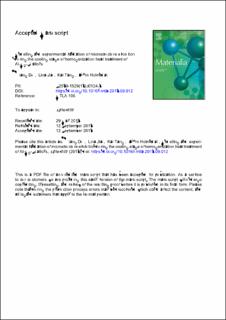| dc.contributor.author | Du, Qiang | |
| dc.contributor.author | Jia, Lina | |
| dc.contributor.author | Tang, Kai | |
| dc.contributor.author | Holmedal, Bjørn | |
| dc.date.accessioned | 2020-12-28T13:50:30Z | |
| dc.date.available | 2020-12-28T13:50:30Z | |
| dc.date.created | 2018-10-08T12:42:36Z | |
| dc.date.issued | 2018 | |
| dc.identifier.issn | 2589-1529 | |
| dc.identifier.uri | https://hdl.handle.net/11250/2721037 | |
| dc.description.abstract | A CALPHAD-coupled multi-component multi-phase Kampmann–Wagner Numerical modelling framework has been adapted and coupled with a homogenization model to predict the competitive nucleation and growth of multi-sized metastable/stable phase particles during the cooling stage of a homogenization heat treatment. The reported model is the continuation of our previous work on the homogenization soaking modelling (Du et al., 2013). It takes the experimentally verified soaking modelling prediction results as the initial microstructural status and predicts the microstructural evolution during the very last step of the homogenization treatment, i.e. the final cooling process. The model has been applied to two Al–Mg–Si alloys: AA6061 and AA6082. The simulation shows a multi-modal MgSi particle size distribution forms due to multiple nucleation events. For the AA6082 alloy the multiple nucleation events occur mainly due to the local micro-chemistry variations along a dendrite while for AA6061 it is due to the two opposite contributions to supersaturation: the positive contribution by the cooling and the negative contribution by the particles' growth. The interaction of intergranular and intragranular MgSi containing particles have been captured, and the partitioning of Mg and Si solutes among the two different sized MgSi particles has been predicted. The model predictions are in reasonable agreement with the microstructure characterization results obtained with Scanning Electron Microscopy (SEM), Transmission Electron Microscopy (TEM) and Electrical Resistivity Measurement on the quenched samples from some dedicated laboratory-scale homogenization heat treatment experiments. It is concluded that the extended KWN modelling framework is applicable to predict the microstructure evolution during the non-isothermal heat treatment of multicomponent aluminium alloys. | en_US |
| dc.language.iso | eng | en_US |
| dc.publisher | Elsevier | en_US |
| dc.rights | Attribution-NonCommercial-NoDerivatives 4.0 Internasjonal | * |
| dc.rights.uri | http://creativecommons.org/licenses/by-nc-nd/4.0/deed.no | * |
| dc.subject | Cooling | en_US |
| dc.subject | Microstructure modeling | en_US |
| dc.subject | Precipitation kinetics | en_US |
| dc.subject | Al alloys | en_US |
| dc.title | Modelling and experimental validation of microstructure evolution during the cooling stage of homogenization heat treatment of Al-Mg-Si alloys | en_US |
| dc.type | Journal article | en_US |
| dc.description.version | acceptedVersion | en_US |
| dc.rights.holder | © 2018. This is the authors’ accepted and refereed manuscript to the article. This manuscript version is made available under the CC-BY-NC-ND 4.0 license http://creativecommons.org/licenses/by-nc-nd/4.0/ | en_US |
| dc.source.pagenumber | 70-80 | en_US |
| dc.source.volume | 4 | en_US |
| dc.source.journal | Materialia | en_US |
| dc.identifier.doi | https://doi.org/10.1016/j.mtla.2018.09.012 | |
| dc.identifier.cristin | 1618673 | |
| dc.relation.project | Norges forskningsråd: 247783 | en_US |
| cristin.unitcode | 7401,80,63,0 | |
| cristin.unitname | Metallproduksjon og prosessering | |
| cristin.ispublished | true | |
| cristin.fulltext | postprint | |

